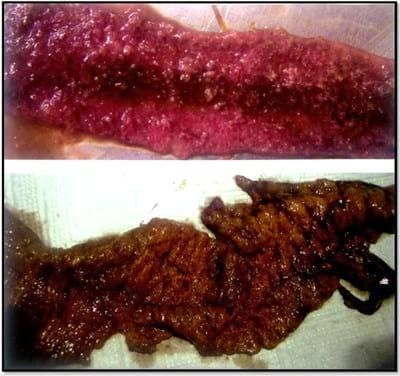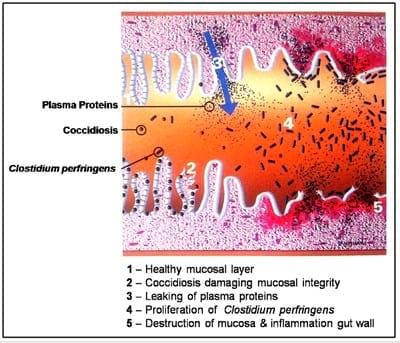Necrotic Enteritis in Poultry
Necrotic Enteritis in Poultry- A Serious Profit Killer

- High dietary levels if viscous grains (Wheat based diets) with animal protein sources (Fishmeal).
- Damage to the intestinal mucosa through prior infection with coccidiosis.
- Infection of birds with salmonellosis
- Increased digestive viscosity due to inclusion of water soluble indigestible non-starch polysaccharides.
- Physical rupture of the gastrointestinal linning by rough litter.
- Intestinal stasis and intestinal distension.
- Rough climatic conditions.
- Improper management.


- Sound cleaning and disinfection of the environment between flocks to decrease the bacterial load in the shed. Improved management, reduced environmental stress, use of clean litter, enhanced biosecurity and sanitation helps to reduce the incidence of disease.
- Diet should be formulated using high quality, highly digestible ingredients with well-balanced amino acid and nutrient profile.
- Drastic changes in the diet should be avoided.
- Improve digestibility of feed so no undigested feed remains in the bird, thereby becoming a basis for bacterial multiplication.
- Any managemental practice that reduces the incidence of coccidiosis will also reduce the incidence of necrotic enteritis.
- Bird diversity is a critical factor in preventing necrotic enteritis so overcrowding of birds should be avoided.
- Control water quality by using portable water. Water should be properly chlorinated.
- Acidification of water can contribute to a reduction of the number of pathogenic bacteria in the gut.
- It is possible to reduce the aggressiveness of bacteria through the use of antiboitics.
- Use of alternative weapons like plant extracts, essential oils and organic acid are able to reduce the total bacterial counts in the gut.
- Birds should be fed additive like probiotics symbiotics through diet or drinking water which affects the balance of intestinal microflora in a positive way and thus able to control enteric pathogens.

It is a good & informative article.We learnt a lot from the article about necrotic enteritis. Can continue use of Enramicyn in the feed help to reduce necrotic enteritis?
Prof. (Dr.) Tufail Banday; Dr. Madeha Untoo and Dr. Henna Hamadani
Thanks for information on the subject, very practical. Is common problem and explained nicely in simple way.
Thanks for sharing .
Kind Regards
Dr Mahendra Chaudhari
India
do acids help in prevention of necrotic enteritis ? i believe acids are very good in controlling gram negative bacteria but as for my experience and knowledge not much effective in case of clostridial infection rather some time acids have negative impact on birds in this disease .
Very good & informative article about Necrotic enteritis.
Here another important thing needs to be discussed and that is the occurrence of the disease in hot and humid weather? In my field experience, I have seen the disease more common in summer than in any other season.


A Natural Choice for Growth Enhancement in Farm Animals - 3 ESSDENDIS
Thanks to Dr. Tufail Banday for the valuable information delivered in the article about Necrotic enteritis. The poultry rearing in our area is a deep litter system . So the intestinal integrity is affected due to the contamination of the poultry house with a diversity of infectious agents , so the article is a contribution to the relief of such a problem . Thanks
Dear : i would like to translate the article about Necrotic enteritis to arabic language so that kindly let me know if there is any problem
With all my best wishes
Dr yahia






















